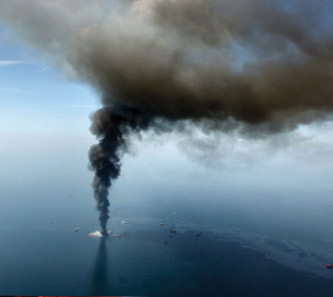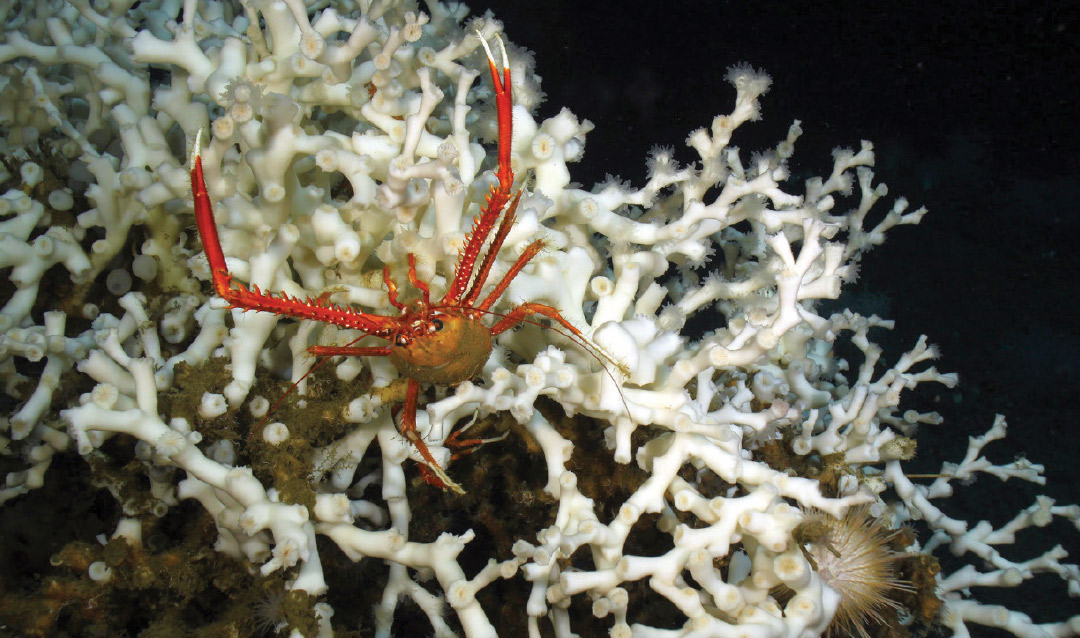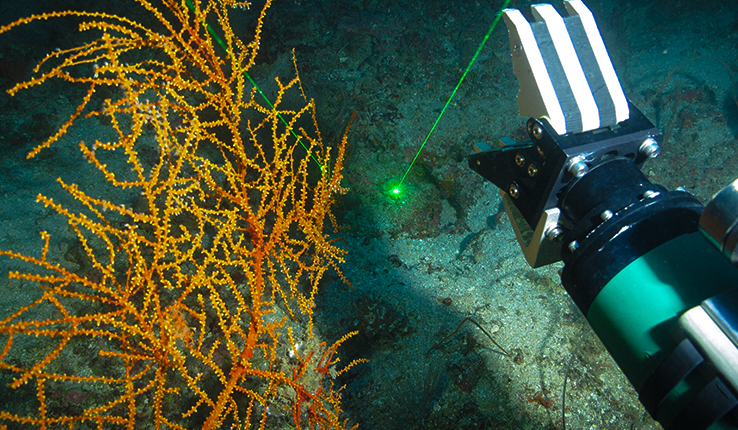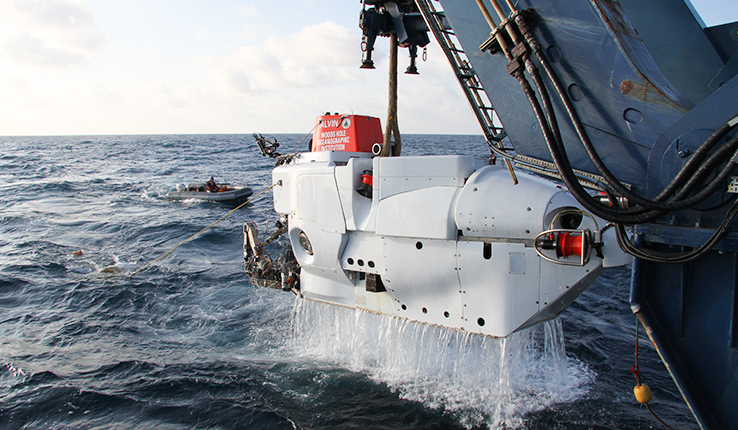Santiago Herrera Dives Deep to Understand Connectivity Patterns in Deepwater Coral Communities
Herrera’s research helps guide decisions about which sites to designate as marine protected areas in the Gulf of Mexico in the years following the Deepwater Horizon disaster.
Stephanie Veto

The 2010 Deepwater Horizon disaster in the Gulf of Mexico resulted in the deaths of 11 oil rig workers and the largest marine oil spill in history. The spill had a catastrophic impact on the Gulf’s vast, interconnected ecosystems. It harmed natural resources as diverse as fish and shellfish, productive wetland habitats, sand beaches, birds, endangered and threatened sea turtles, protected marine mammals—and deepwater coral communities.
Living deeper than 150 feet, deepwater corals are marine invertebrates, a group of animals without a backbone. Their branch-like structures serve as the foundation of many ecosystems in the Gulf, providing habitats for diverse and abundant fish communities to thrive and reproduce. Ensuring the restoration and sustainability of the Gulf’s deepwater corals is key to ensuring the restoration and sustainability of the Gulf, says biological oceanographer Santiago Herrera.
“We consider these species ecosystem engineers,” says Herrera, an assistant professor of biological sciences. “Corals are threatened by many things: environmental change, global warming, ocean acidification, physical damage from overfishing, and also pollution, things like oil spills, for example. To make sure that we continue benefiting from those resources and the services that these species provide, it’s important to manage them well.”
Herrera leads teams of researchers working to address crucial gaps in the understanding of the processes that shape population connectivity patterns in deepwater corals living in the Gulf of Mexico, including species directly impacted by the Deepwater Horizon oil spill. Their research helps guide decisions about which sites to designate as marine protected areas and informs their management.

A crab crawls along Lophelia corals at a depth of more than 1,600 feet in the Gulf of Mexico.
Uncovering Coral Connections
Little is understood about how the Gulf’s spatially discrete, island-like coral communities are connected to each other. Understanding the relationship between the communities is important for determining their reproductive patterns and, ultimately, for achieving their full regeneration.
“If you protect the source population, then effectively you might also be contributing to the health of the downstream population. But if you only protect the downstream population [and] it turns out that most of the new generations are coming from the distant population, then you’re not doing a good job. So understanding those dynamics and the connection between the networks is important to make sure your management strategies work well,” says Herrera.
Learning how closely related individual corals are between locations tells researchers how much the corals are reproducing among different sites.
“That’s important for a number of reasons,” Herrera explains. “The basic science of it is to understand how diversity is structured in the ocean. We have a much better grasp of answering that question on land ... but we have a much lesser understanding of what factors are at work or whether they are important or not in the ocean, particularly when we look deeper because it’s an entirely different system.”
The deep ocean, says Herrera, provides a more stable environment in which the effects of storms or seasons are not as pronounced. No matter where you go on the planet, the deep ocean is dark and cold—but there’s also quite a bit of life and quite a bit of diversity among the species found there. And, he says, there’s still so much to learn.
“We know much more about the surface of the moon or the surface of Mars than the deep ocean. There’s still a lot of discovery happening,” he says.
With the support of a grant from the National Oceanic and Atmospheric Administration (NOAA) RESTORE Act Science Program, Herrera and his colleagues—including co-principal investigators Andrea Quattrini of Harvey Mudd College; Annalisa Bracco of the Georgia Institute of Technology; and Peter Etnoyer of the National Centers for Coastal Ocean Science, a group within NOAA—conducted three expeditions to the Gulf in 2017 for field sampling and data collection. They sought to determine the diversity and genetic structure of key coral populations and to identify the direction and rate of genetic exchange among coral populations to establish which ones are the source of the most successful larvae—the coral’s “seeds” that eventually form new colonies.
The team spent weeks gathering samples of coral with remotely operated vehicles. They then brought those samples to their lab. Using a state-of-the-art population genomic analysis approach called restriction-site associated DNA sequencing (RADseq)—pioneered by Herrera for use in corals—and predictive models of larval dispersal, the team estimated how far particular coral “families” spread and determined connectivity patterns among coral populations.
“We compare genetic diversity among individuals within a population and among populations within a species and among different species,” says Herrera. “And we do this at different depths because we know that processes vary in the ocean with different depths. And so with all this information, we’re generating a picture of how genetic diversity is distributed in this region, and we’re finding out some things that are surprising.”
The team expected to find that corals located near each other would be more genetically similar to each other than to corals that are more distant, and that’s what they did see. But, Herrera explains, as the team looked deeper into the ocean, geographic distance did not appear to be as strong a predictor of genetic relatedness—but depth did.
“We can have two different populations of the same species that can be separated by hundreds of miles horizontally, but they are genetically indistinguishable if found at a similar depth,” explains Herrera. “But then we have two populations at maybe a couple hundred meters in depth difference and geographically they are only tenths of miles apart—so, pretty close—but they are genetically distinct. We’re learning that the connectivity between the populations is dictated more heavily by the depth where they live rather than by the geographic distance that separates them.”
This discovery led the team to suggest moving away from a two-dimensional model of management, where they draw boxes on a map to designate recommended protected areas, to a more three-dimensional model that includes depth. That complicates things, says Herrera.
“We try to be as comprehensive as possible, but ... we’re obviously not sampling every single population of these corals that exist in this region because we’re only sampling places where we know these corals exist. And there’s a lot of the ocean that is unexplored … So we have to strategize and prioritize what data we collect, what would give us the best, the most information.”
Modeling for the Future
The predictive modeling component of the project, which forecasts where coral larvae will go based upon the movement of ocean currents, is led by Annalisa Bracco of the Georgia Institute of Technology.
“These models can tell us with confidence what the ocean was doing at any time in the past where we have data,” says Herrera. “[Bracco] is able to generate models of ocean circulation in the Gulf of Mexico for entire years but also at a resolution of hours.”
The team uses a supercomputer to simulate ocean activity, release virtual larvae and track them to see where they go over a certain period of time. They can repeat the simulations over and over again, introducing new parameters and adding real-life complexities, to generate predictions of where coral larvae will end up in time. These predictions help the team identify connections between populations, which they can then test using the genetic data. They can also test when in the year different populations of corals are reproducing, and also predict the locations of corals in areas they haven’t sampled.
“We can create networks of connectivity where we can predict the big picture of what population dynamics in the entire Gulf of Mexico look like,” says Herrera.
The Flower Garden Banks National Marine Sanctuary, the only federal marine protected area in the Gulf of Mexico and a co-collaborator on the project, has proposed an expansion of the boundaries of its current protected areas. The information the team provides can help guide their decisions.

Herrera and his team gather samples of corals. (Credit: Santiago Herrera, FGBNMS/UNCW-UVP)
Expanded Exploration
A second NOAA grant, awarded in 2018, supports a significant expansion of the team’s exploration of connectivity among coral populations to shallower areas of the Gulf.
“We’re trying to make connections with shallow reefs in the Gulf of Mexico, so [we’re] looking at a larger spatial distribution. We are investigating how they’re connected to deeper parts through the Gulf of Mexico—vertical and horizontal connectivity,” says Herrera, who serves as lead of this project as well.
The expanded project more than doubles the original project’s biological cover, increasing the focus from four species of corals to eight. The larger team, which includes members of the original core team as well as collaborators from the Smithsonian Institution, the United States Geological Survey and others, is also studying sea sponges and fish. Work will continue this spring with genetic connectivity and predictive modeling, but will also incorporate the microchemistry of tissues of animals to examine connectivity within a species but also in interactions among species.
“The elemental compositions and the isotopic compositions of different [animal] tissues tell us things like whether, for example, a fish grew up in an environment [and] then as an adult migrated to a different environment,” Herrera says. “That gets recorded in the otoliths. The bone structures that exist in the inner ears of the fish grow kind of like trees—they grow rings. So the whole story of the surrounding environment they’re growing in gets recorded. We can start asking questions like, did this fish move from one place to another or did it stay its whole life in one place? Also, we can look at trophic connectivity: who’s eating who and where.”
The team measures the environmental parameters where animal species live and collects data from the entire Gulf.
“We can then say, ‘We know that these species have these particular environmental requirements. Where else does this set of parameters exist in the Gulf of Mexico?’ We can calculate probabilities of where to find them, and we can incorporate those in the models of larval dispersal to get the big picture,” Herrera explains. This, too, can inform protection strategies.
This approach to coral recovery—leave them alone and make sure they don’t experience unnecessary stressors—takes a long time. Corals grow slowly, so the outcomes of Herrera’s efforts may not be seen for generations.
“We know that this will take a long time, decades to centuries in some cases, to see anything change,” Herrera explains. The idea, he says, is to “give the communities a better shot at surviving.”
And if deepwater corals have a better shot, then the Gulf of Mexico will, too.

Alvin, a submarine operated by the Woods Hole Oceanographic Institution (Credit: Rika Anderson)
Diving Deep
Herrera participated last December in an NSF-funded expedition of early-career scientists to the East Pacific Rise, one of the most carefully studied parts of the Mid-Ocean Ridge system. The Mid-Ocean Ridge is the largest mountain chain on the planet, and 90 percent of it is underwater.
“It’s a place where tectonic plates are moving away from each other, so there’s new seafloor being formed, new Earth’s crust,” Herrera explains. “...There’s a lot of volcanism and a lot of heat energy released in these places, and so from a geological perspective, it’s a really interesting place to understand how the surface of our planet is formed.”
The heat energy in this region also causes the formation of deep-sea hydrothermal vents, which serve as a home to unique ecosystems that harvest energy from the interior of the Earth rather than from the sun.
“Animals in these places are uniquely adapted to thrive in extreme conditions at deep-sea vents. They do it by collaborating with bacteria: chemosynthesis as opposed to photosynthesis ... These species are also some of the fastest growing animals on the planet,” says Herrera. “It’s an oasis for life in the deep ocean, [and] a few meters away it’s just barren rock. You don’t see such a high abundance of life in one place anywhere else in the deep ocean. And these are some of the places where we think life originated on the planet. These kinds of ecosystems are important in the history of life on Earth.”
Herrera and his fellow participants dove in Alvin, a submarine operated by the Woods Hole Oceanographic Institution, to gather data and witness these ecosystems firsthand. They also collected samples and data with Sentry, an autonomous underwater vehicle.
“One of my lifelong dreams has been to dive in a submarine, and this was the first time I’ve done it,” says Herrera. “It’s a much different experience to see things with your own eyes than with the camera. You get the three-dimensional perspective of everything.”
Work within FGBNMS under permit number FGBNMS-2017-007/A1 and FGBNMS-2019-003
Story by Lori Friedman and Kelly Hochbein
Main illustration by Phil Wheeler
This story originally appeared as "Deep-Sea Discovery" in the 2019 Lehigh Research Review.
Stephanie Veto





